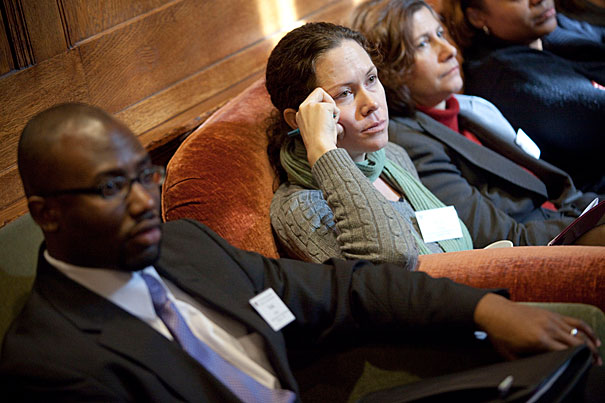
Isaac Cherry (left), manager of Endowment and Gift Funds, and FAS recruiter Kim Ohman listen to various scenarios during the “Bystander Awareness Workshop,” part of the Diversity Dialogue Series.
Kris Snibbe/Harvard Staff Photographer
Don’t just stand there
Workplace strategies on what to do when diversity is challenged
Like most city dwellers, Robin Parker is used to uncomfortable public moments. “Riding back and forth on the T, I see a lot of things,” she said.
But one recent evening, her attention was drawn to a group of teenage boys in prep-school khakis and their loud, crude insults about women and African Americans. Unsure whether to speak up, she finally targeted the most vulnerable-looking boy. “You’re too handsome to be talking like this on the train,” she told him.
“They dropped their heads, stopped the conversation, and apologized,” said Parker, manager of Harvard’s Events and Information Center. Before she got off the train, a white man approached and thanked her, a black woman, for saying what he couldn’t.
As Parker relayed her story in the Barker Center, a hush fell over the crowd. It was the end of a Dec. 7 workshop on bystander awareness, and many participants had confessed how helpless they often feel in such situations.
“It’s about being able to bring the unspoken into a moment comfortably,” Parker said. But not everyone manages to be so gracious — or effective — when countering behaviors or remarks that touch on race, ethnicity, gender, or sexuality in the workplace. Everyone has a story of, say, a female team member being ignored at a big presentation, a co-worker unknowingly using a racially charged figure of speech, or a minority colleague being mistaken for waitstaff at a networking reception.
But in the moment, employees often clam up out of embarrassment, confusion, self-doubt, or other reasons. In the process, they miss opportunities to show solidarity and reinforce diversity as one of Harvard’s key values, said workshop co-leader Maureen Scully, assistant professor of management at the University of Massachusetts, Boston.
That hesitancy can be overcome with the proper awareness and practice, said her fellow presenter Stacy Blake-Beard, associate professor of management at Simmons College.
“It’s like CPR training,” Blake-Beard said. “By practicing it, it becomes instinct.”
The session was part of the Diversity Dialogue series hosted by the Faculty of Arts and Sciences’ Human Resources Diversity Initiative. The workshop drew participants from Schools and departments ranging from the Harvard University Police Department to Hospitality and Dining Services.
As small groups acted out bystander responses to various scenarios, Blake-Beard and Scully emphasized how critical bystander support has become in increasingly diverse universities and businesses.
“Now more than ever, as we are collaborating and competing with people who are so different from us … we need to know how to leverage differences,” Blake-Beard said.
Some simple bystander strategies they suggested include:
- Reset the situation. Draw attention to a slight or inappropriate remark by using humor, calling for an end to the conversation, or merely saying, “Ouch.”
- Include someone who is being ignored. Introduce the person by name, and use welcoming body language and conversational segues to bring the person into the dialogue.
- Facilitate conversation, but don’t dictate. If your colleagues are at an impasse over a touchy issue, ask clarifying questions, paraphrase them respectfully, and ask for help from a third party if necessary. Don’t gang up.
While the workshop’s core examples addressed gender and race, attendee Joseph Powers, director of group therapy at Harvard-affiliated McLean Hospital, said bystander mediation skills have much broader applications.
“I listen to patients all the time who are concerned about bias and prejudice toward people with psychiatric illnesses,” Powers said. “I wanted to learn some strategies to counter the bystander effect, skills that I could teach them. I think I got some good ideas.”




